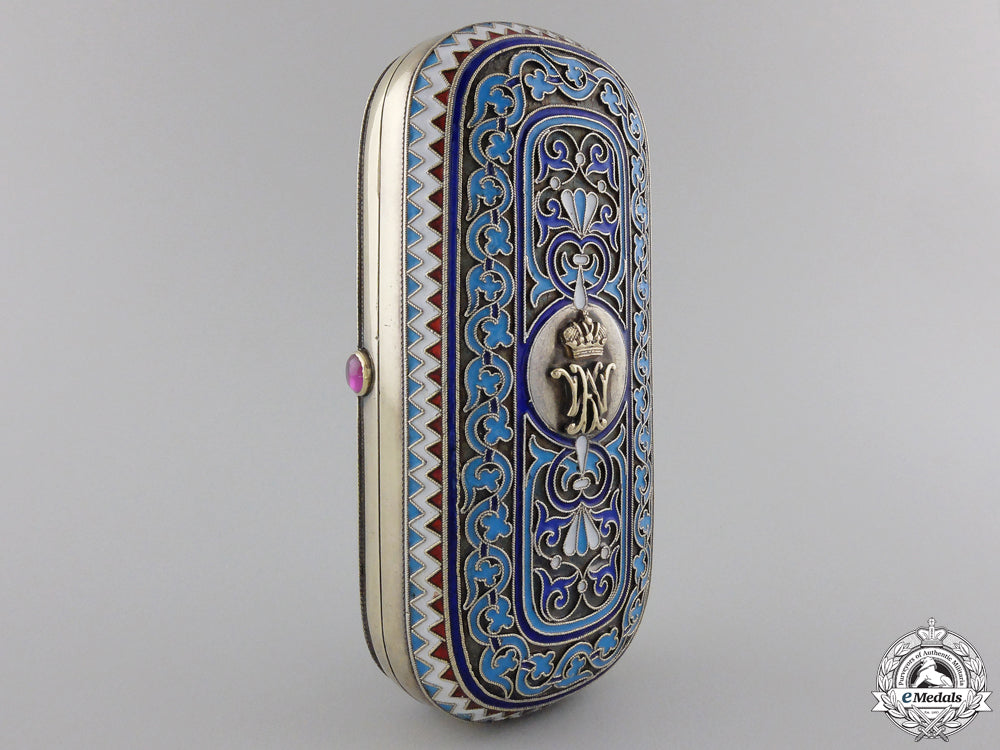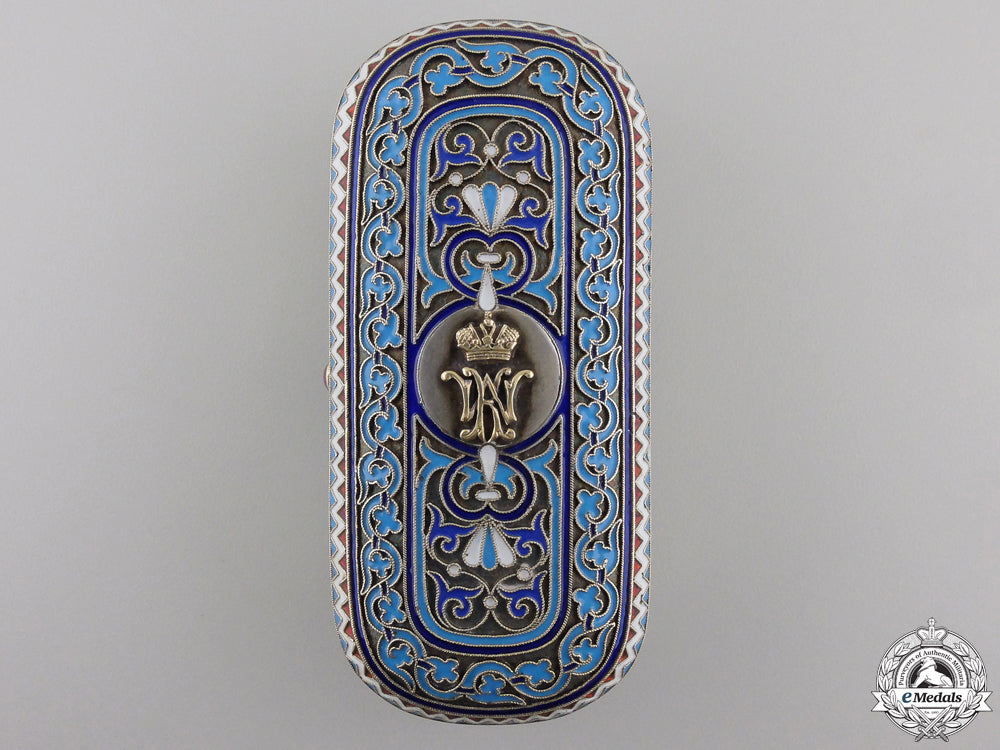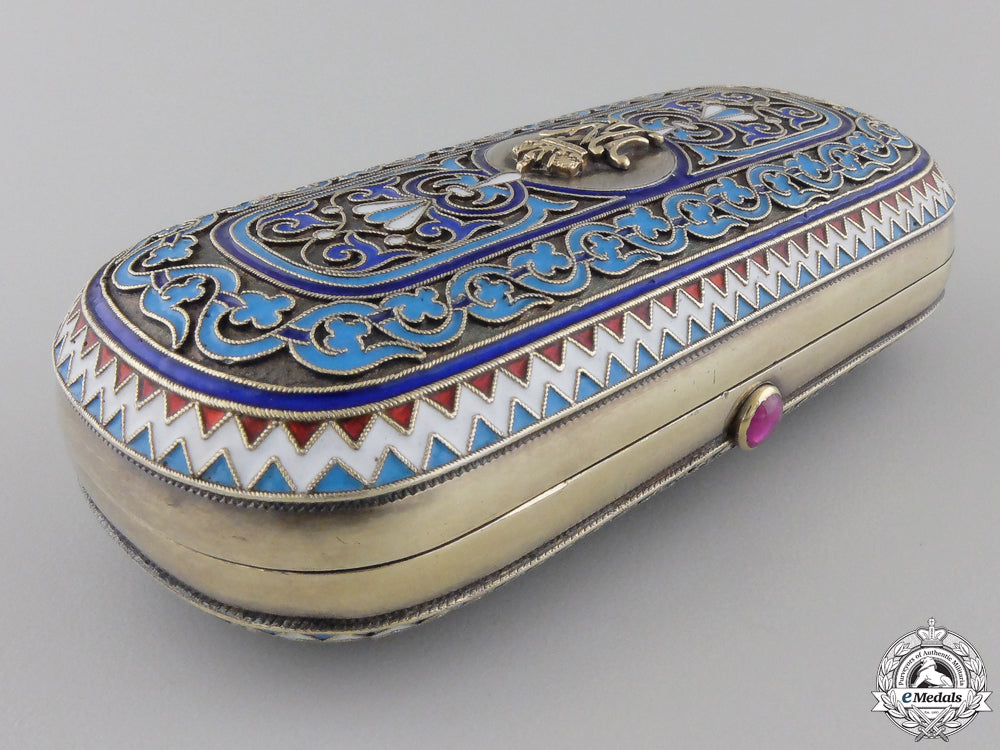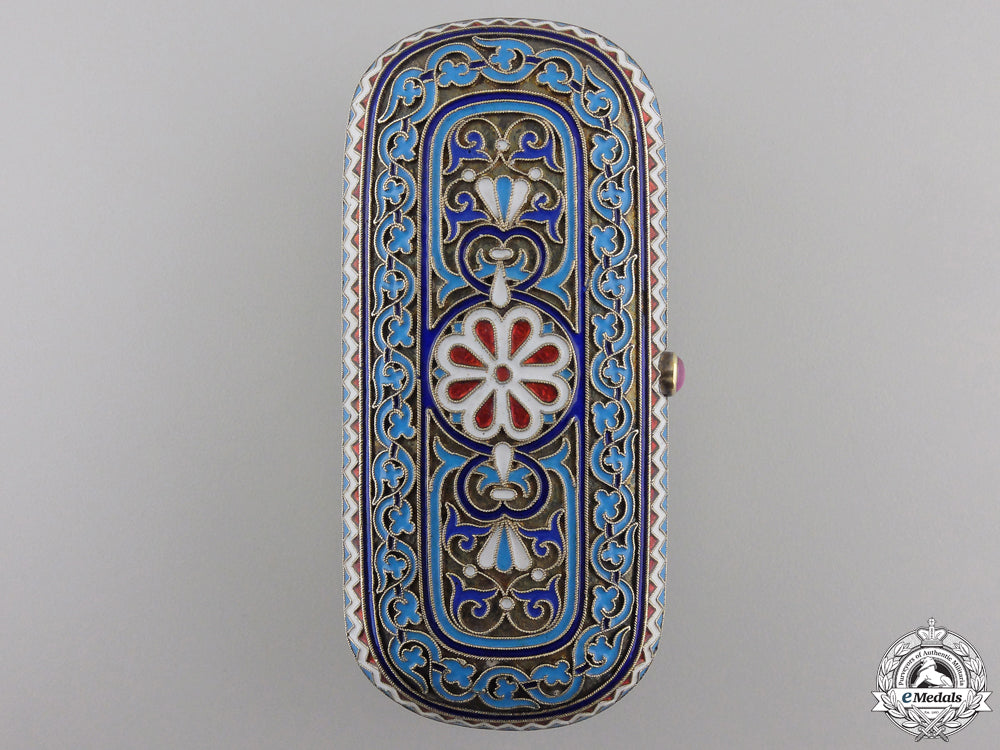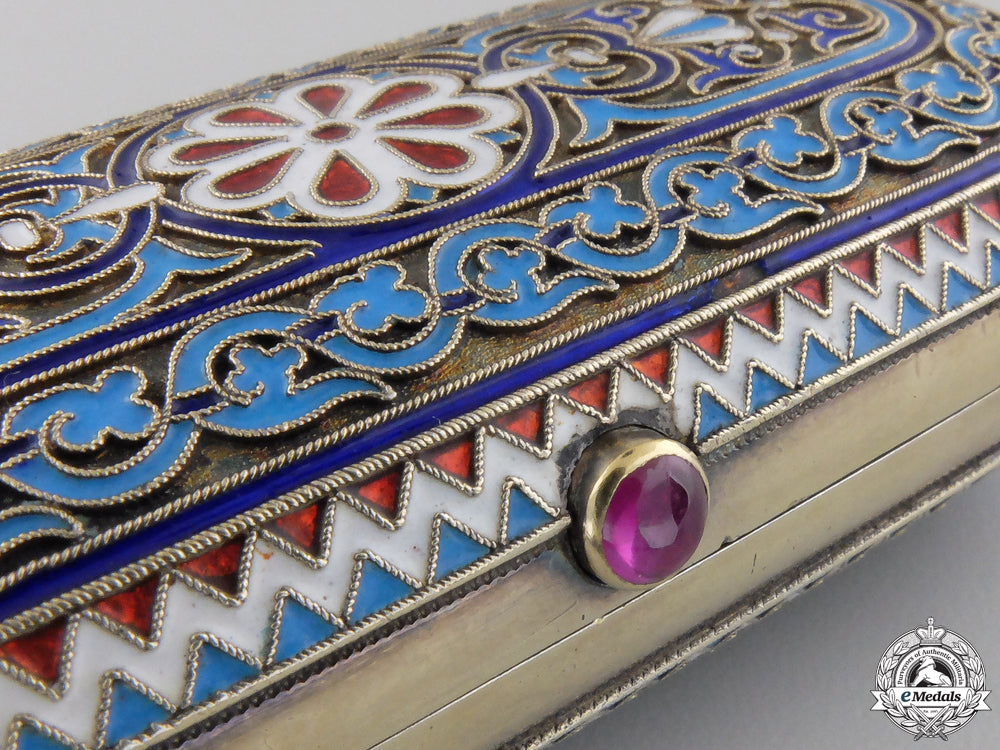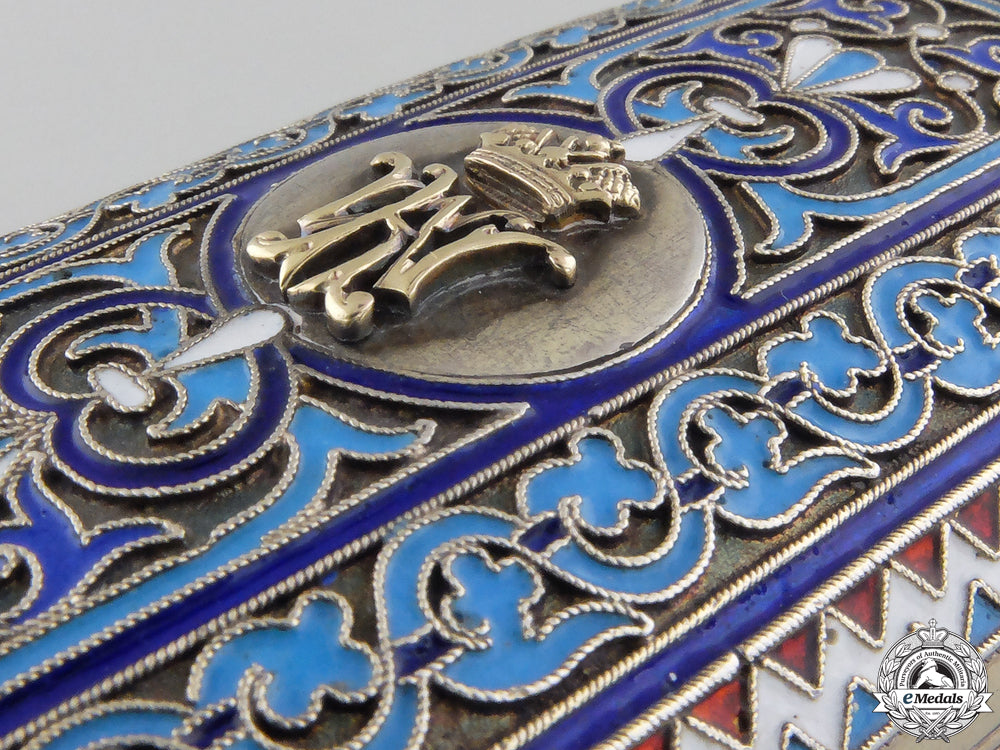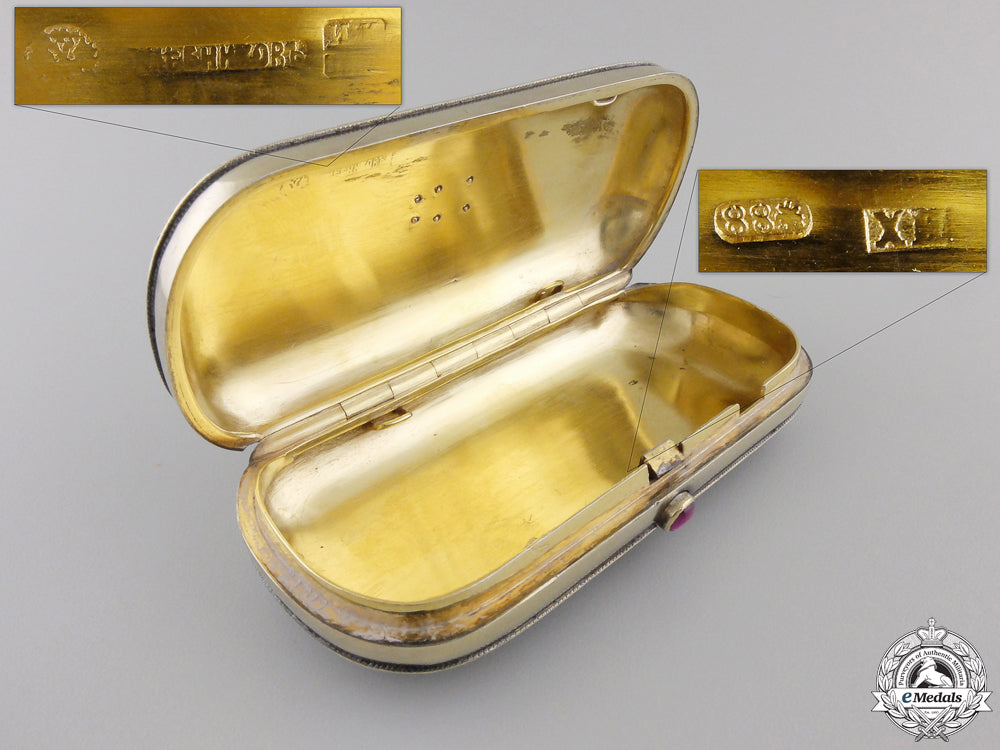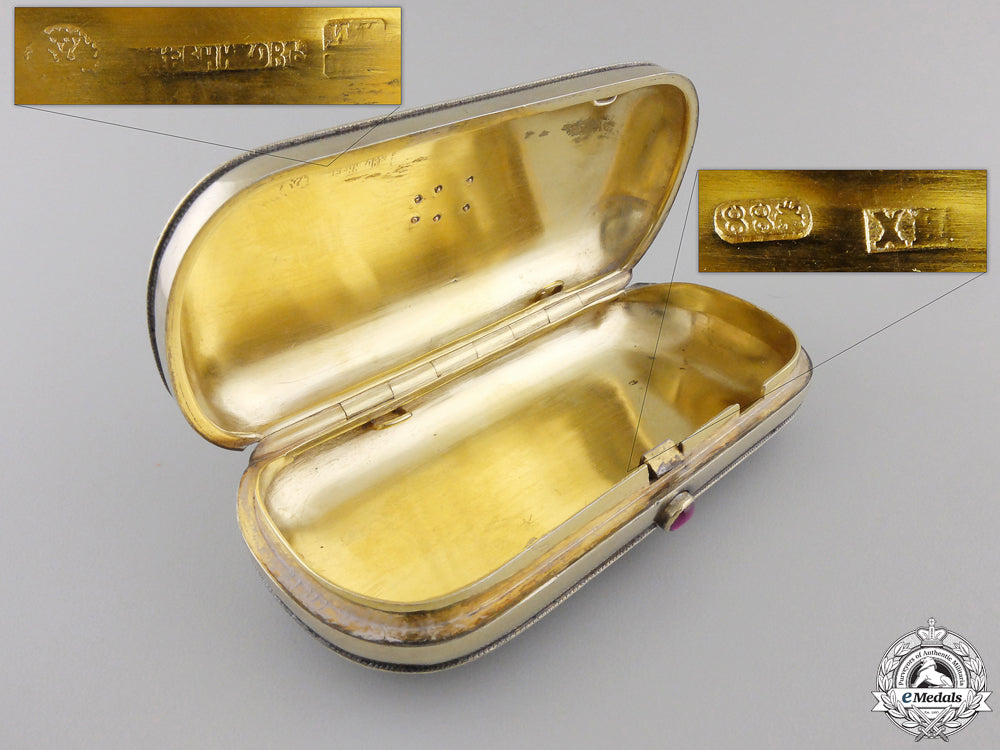Description
An Exquisite Russian Box to the Duchess of Wurtemberg - On silver with enamels. Cabochon ruby release and cypher of Grand Duchess Vera of Wurttemburg (Germany). Maker marked on silver gilt interior "Klebnikov" with dual hallmarks. 40.5 mm x 90.5 x 28 mm in height, weighing 111 grams, of the finest Russian quality, bright colours, and stunning detail, mint.
Footnote: Grand Duchess Vera Constantinovna of Russia (later Wurttemberg) (February 16, 1854 - April 11, 1912) was the daughter of Grand Duke Konstantine Nicholaievich of Russia and Grand Duchess Alexandra Iosifovna (born Princess Alexandra of Saxe-Altenburg). She was a grandadughter of Tsar Nicolas I and first cousin of Tsar Alexander III of Russia.She spent her early years in St Petersburg and in 1861, the family moved to Warsaw when her father was appointed Viceroy of Poland. Vera was a troubled child, prone to violent fits of anger, and suffered what was officially described as a "nervous condition". She became so unmanageable that her parents decided to send her to her aunt, Grand Dichess Olga, Queen of Wurttemberg, who agreed to take care of her. On December 7, 1863, Grand Duke Constantin and his wife arrived with nine-year-old Vera in Stuttgart, entrusting her care to the childless King Karl of Wurttemberg and Queen Olga. Officially this was ascribed to the more advanced medical treatment the child would receive in Germany, but it was also a way for Vera's parents to hide her embarrassing illness from the Russian court. Queen Olga was happy to take care of her niece in spite of the difficulties, and for Vera, her aunt eventually took the place of her mother.Queen Olga and her husband were devoted foster parents, but in the beginning, they had little success in improving the girl's condition. Vera was homesick and continued to be extremely difficult, to the point of being physically violent towards them. Periodically, Vera had to be brought under control by an army officer, and on more than one occasion she was locked up. Karl went for long walks with Vera and read passages from the Bible to her in the evening. By 1866, there was still little improvement in Vera's condition, but Queen Olga persevered and with time, Grand Duchess Vera eventually outgrew her disruptive behavior. As a young woman, she was introspective, shy, but clever with an intellectual bent. She disliked ceremony. Her physical appearance, like her personality, was rather peculiar. She had thick, curly blonde hair, but was short, stumpy and extremely plain.King Karl and Queen Olga legally adopted Grand Duchess Vera in 1871. They arranged her marriage to a member of the Silesian branch of their family, Duke Eugen of Wurttemberg, as in this way she would not have to leave the country after her marriage. The engagement took place in January 1874, pleasing both families. Grand Duke Konstantine wrote to the King and Queen profusely thanking them for the help they had given to his daughter. Queen Olga wrote to her friend Marie von Kinderlen-Waechter, "My problem child is now a happy bride, loving and beloved. I never dreamed that such happiness could exist. Eugen is already like a son to the King. I fold my hands and thank God day and night for such a blessing.". Even the heir to the Wuerttemberg throne, Prince William, wrote that Vera was the luckiest bride in the world. "While she is very ugly and will always remain so, compared to how she was as a child she is unbelievably improved. I consider her not to be without accomplishments, and, I believe, not without heart." Vera was nineteen and Eugen twenty-eight. The wedding was celebrated with great pomp in Stuttgart on May 4, 1874 in the presence of Vera's uncle, Tsar Alexander II, who, noticing the unattractiveness of his niece, remarked ungallantly, "I confess that I do not envy the young husband". He did, however, arrange for Vera's father to settle a million rubles on her as a dowry. The couple settled in a large house, the "Akademie" in Stuttgart. The following year, Vera gave birth to a son, Karl Eugen, who died only seven months later. In 1876, Vera had twin daughters, Elsa and Olga. However, the Grand Duchess' married life was to be short-lived. Her husband, an officer in the Wurttemberg army, took charge of a command in D?sseldorf, where he died unexpectedly on January 27, 1877. The cause of death was officially given as, alternately, a fall from a horse, and a respiratory illness. However, many believed the Duke, a well-known "bon vivant", had actually been killed in a duel, which was hushed up. The marriage had lasted three years. Only twenty-three years old, Vera never married again. She reacted to the death of her husband in practical, not grief-stricken terms. Rather than returning to her native country, the young widow decided to stay in Wurttemberg, the country she felt to be her own, where she had the protection of the King. However, she traveled frequently to visit her relatives in Russia as well as her only sister, Queen Olga of the Hellenes, in Greece.At the death of King Karl in 1891, Vera inherited a considerable fortune, and when Queen Olga died a year later, she received Villa Berg in Stuutgart, where she lived in considerable style. She also wrote poetry, and her home was the scene of many cultural as well as family gatherings. Bright and talkative, Grand Duchess Vera was popular in W?rttemberg, where she dedicated herself to charitable work. Refuges for fallen women, called "Vera's Homes"; the Benevolent Institution; the Olga Clinic in Stuttgart; the Nicholas nursing station for the blind, the Mariaberg Institute near Reutlingen, the dragoon regiment of her late husband, and a Russian regiment, were among the more than thirty institutions and organizations under her patronage. She was also involved in the construction of the Orthodox Church of St Nicholas in Stuttgart.Grand Duchess Vera visited Russia often and was present with her daughters in May 1896 during the coronation ceremonies of Tsar Nicholas II. The elder of the twins, Elsa, was first engaged in January 1895 to Hereditary Prince Alfred of Saxe-Coburg-Gotha, a grandson of Queen Victoria. The engagement was quickly broken off, and Elsa married a distant cousin, Prince Albert of Schaumburg-Lippe, brother of Queen Charlotte of Wurttemberg. The following year, Vera's other daughter, Olga, married her brother-in-law's younger brother, Prince Maximilian of Schaumburg-Lippe. Olga's fate was similar to Vera's; she had three children and within a few years of her marriage, she lost a child and her husband, becoming a widow at an early age and never marrying again. Aged beyond her years, Grand Duchess Vera was now in poor health. Some authorities now speculate that she suffered from Sydenham's chorea or Saint Vitus Dance, a neurological movement disorder characterized by abrupt, involuntary movements. In Stuttgart, Vera was assigned an officer to follow her about, to make sure that if she had an attack she would not fall and injure herself. By the turn of the century, Vera Constantinova appeared small and dumpy with a fat, round face. She wore her hair very short, which gave her a masculine look. Extremely nearsighted, she wore a pince-nez (spectacles supported without earpieces). She was considered rather eccentric, but she had a good sense of humor and her funny remarks were remembered by her nephews and nieces. She was well liked by her family.After living in W?rttemberg for so long, she was at odds politically and religiously with her Russian relatives. Her political sympathies lay with Germany and she did not share the increasingly anti-German view of the Romanovs. Vera Konstantinovna was very religious, but had never understood the Orthodox faith and eventually abandoned it to convert to Lutheranism in 1909, to the consternation of the Romanov family. She then commissioned the building of a Protestant church on the grounds of Villa Berg. Grand Duchess Vera Constantinovna suffered a stroke in October.

